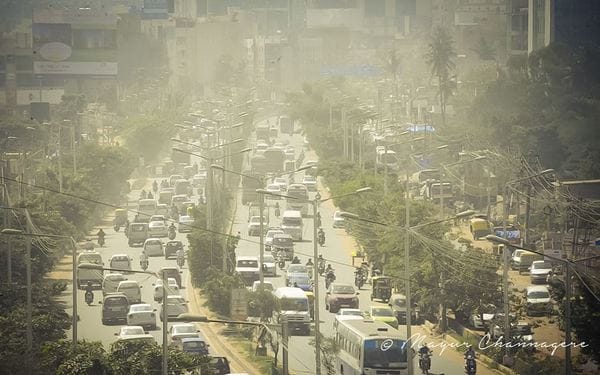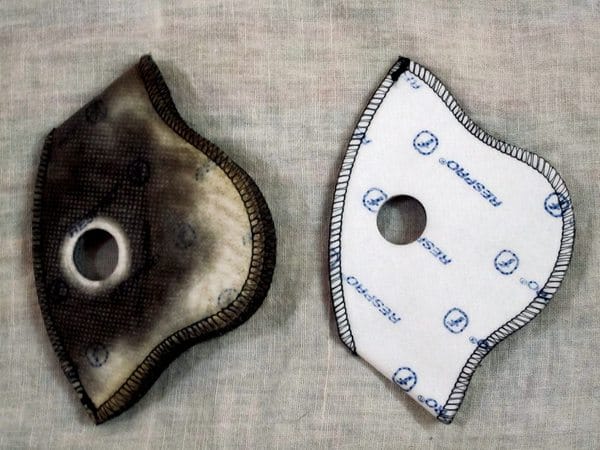
Pic: Mayur Channagere
If you are someone who rides a bike for more than four hours in Bengaluru every day, there’s a significant chance that you will develop Chronic Obstructive Pulmonary Disease (COPD). COPD, which makes breathing difficult, is a leading cause of disability and death globally; it is irreversible and worsens over time.
The conclusion is from a study on 100 non-smokers in Bengaluru aged 25-40 years, who commute to work by bike. Given the worsening traffic jams in the city, the number of people riding bikes for over four hours per day could be quite high.
But respiratory diseases like COPD are not the only risks from air pollution. Many global studies have shown that air pollution can cause many non-communicable diseases (NCDs) like heart diseases, stroke, lung cancer, low birth weight and congenital disorders like cleft palate. For example, a recent review of studies between 1990 and 2014 from 28 countries showed that stroke-related deaths and hospitalisations were closely linked with air pollution, and that the correlation was strongest in low and middle income countries.

Pictures of a cyclist’s mask – before and after the use. Pic: Akshay Yadav
Some other studies have shown air pollution’s correlations with lung cancer and heart diseases, Alzheimer’s disease, low birth weight and smaller head circumference in newborns etc. Children are more at risk, and could suffer lasting health impacts. Elderly are also more vulnerable because of their weaker immune system.
Here is a personal story of a cyclist from the city of Bengaluru.
Very little data on health impacts
First, there is no data on Non Communicable Disease (NCD) trends over the years for Bengaluru.
Neither Bruhat Bengaluru Mahanagara Palike (BBMP) nor the state government collects comprehensive NCD data.
Second, there are very few studies on the health impacts of air pollution.
The lack of disease registries and digitised hospital records makes such epidemiological studies more difficult, says Dr R S Dhaliwal, Scientist ‘G’ at the NCD Division of Indian Council of Medical Research (ICMR), Delhi. He says that short term studies especially, can be easily done using such data.
Third, there are no recent studies on the specific pollutants in Bengaluru, and their sources.
World standards much higher than Indian ones
In many Western countries, air pollution became a concern over 50-60 years back when it started to cause deaths. Since then, many countries have developed robust pollution control strategies based on research.
For instance, the US Environmental Protection Agency (USEPA) of the United States, conducts its own scientific studies and also gives grants to other organisations for research. Many pollutants were banned because of strong scientific studies that showed their impact on humans. For eg., research in US in the 1970s showed that CFCs (chlorofluorocarbons) were depleting the ozone layer which could lead to cancer, cataract etc in humans. Despite strong protests from industries, in 1978, US, Canada and some European countries banned the use of CFCs in aerosol spray cans.
When further research in the 1980s showed more severe impact of CFCs, it led to three international agreements to phase them out.
According to WHO’s Global Burden of Disease Report, 6.2 lakh premature deaths occurred in India due to outdoor air pollution in 2010 alone. It said that outdoor air pollution was the fifth largest killer in India, and indoor air pollution the second.
Studying Bangalore’s pollutants
Particulate matter – specifically PM10 and PM2.5 – is considered the most common and dangerous pollutant in India. PM, or Particulate Matters, is a mixture of many solid and liquid particles suspended in the air; its composition varies across different regions. Particles with diameter less than 10 μm(micrometer, i.e., one-millionth of a meter) are called PM10, and those with diameter less than 2.5 μm are called PM2.5; PM2.5 is more harmful than PM10.
As per data from the CPCB (Central Pollution Control Board):
- 57% increase in PM10 between 2010 and 2014 in Bengaluru
- In 85% of the monitoring locations, the levels have begun to exceed the standards. The worst hit pollution hotspots include Graphite India Whitefield; AMCO battery Mysore Road; Silk Board Hosur; and Victoria hospital.
In Bengaluru, the KSPCB (Karnataka State Pollution Control Board) has 15 monitoring stations – 13 of these are manual stations that analyse data twice a week, and two are automated ones collecting continuous data. These stations measure only three parameters.
Three other stations directly come under the CPCB; these monitor 21-27 parameters. Data from these three stations are used to calculate the Air Quality Index (AQI) for the city.
Sumit Kumar Gautam, a Fellow at TERI (The Energy and Research Institute), says that these measurements can only show if air quality is good or not. It cannot identify the specific pollutants that make up PM, and also cannot identify their sources. Without knowing this, one would not know what pollution sources to control. To get such data, source apportionment studies are needed.
No action on studies done
In 2007, CPCB and MoEF oversaw source apportionment studies done by different organisations for six cities, including Bengaluru. The Bangalore study was done by TERI, and Gautam was part of the research team. The study recommended many measures like wall-to-wall paving of roads, controlling the number of vehicles, shifting from BS IV to BS VI fuel vehicles directly etc. Gautam says that hardly any of these recommendations have been implemented. “In fact the number of vehicles have doubled since 2007.”
The study had also recommended that further source apportionment studies should be done once every three years. But no study has been done since 2007 at all for Bangalore. The 2007 study itself was commissioned based on the recommendations of Mashelkar Committee Report of 2003, which had pointed out the lack of scientific data on air pollution.
Gautam says that such studies are needed because only a few pollution sources can actually be controlled. Source apportionment studies identify the sources of PM (road dust, vehicles etc) and the extent to which each source contribute to PM. Next, the individual pollutants emitted by each PM source is identified by chemical characterisation. For eg., road dust includes pollutants like aluminium and silica. “Sometimes the source that contributes the most to PM may not have the worst impact. May be the source that contributes only 25% to PM has the worst carcinogens and needs to be controlled,” says Gautam. In addition to PM, inventory of other pollutants like carbon monoxide, and their sources, are also needed.
He says that without knowing which sources are more harmful, we may end up controlling those that don’t really matter, and realise it only after many years.. Such confusion was recently seen in Delhi upon implementation of odd-even vehicle policy; there were debates on whether vehicles actually contributed the most to pollution.
No funds for studies!
But Gautam says that TERI has had difficulty getting funds for source apportionment studies, despite being in touch with government agencies and corporates. “Organisations like IISc and TERI have the technical capability for these studies. But such a study in Bangalore would cost around Rs 1.5 crore.”
A senior officer at the CPCB South Regional Office in Bangalore opines that even if such studies are done, there is hardly any government action to reduce pollution. “Also, CPCB’s main role is to monitor pollution rather than research.”
S Suresh, scientist in charge of CPCB South zone office in Bengaluru, says that CPCB does not have sufficient specialisation and manpower to do such studies by itself. “Getting other organisations to do studies is a policy decision. And such decisions are made by the Member Secretary of CPCB based in Delhi.”
However, conducting source apportionment studies is part of the Terms of Reference (TOR) of a newly constituted committee under the KSPCB Chairman. It has to be seen whether the new committee will actually help advance such research.
Gautam says that research is needed for conclusive proof to push for action. “Earlier, big particles like those emitted by coal trains were considered dangerous. Only with advancement of science, we realised that it is actually PM10 that’s dangerous, and later that PM2.5 is even more dangerous.”
Health impact studies not done
There are many health impact studies on air pollution in developed countries, but researchers say that these studies only give a broad idea, and cannot be directly applied to India. Health impacts may differ here because the type of pollutants and the level of exposure are different.
For example, India’s major pollutants like coal and diesel exhaust are not major pollutants in many developed countries; so studies done in developed countries would not capture health impacts in India. Differences in population and vehicle densities, lack of home air-conditioning also cause different health impacts. Also, in India, urban poor and some professional groups like traffic policemen have worse exposures than general population.
“Differences in weather – temperature, rains etc – also lead to different health impacts. Lifestyle factors like malnourishment also have a huge role,” says Dr George D’Souza, Dean at St John’s Research Institute, Koramangala. He says that genetic factors may also make a difference.
“For example, Indians’ lungs are much smaller than that of Europeans. We don’t know if it’s a good thing or bad. Smaller lungs may mean that we are taking in lesser quantity of pollutants, but it could also mean that the surface area for absorbing pollutants is smaller and hence impact is higher.”
Does air pollution reduce birth weight?
The first long-term study in India on the health impacts of air pollution started in 2010 at the Department of Environmental Health Engineering in Sri Ramachandra University, Chennai. The study, costing Rs 5 crore, was funded by ICMR. Its results are yet to be fully analysed, but a preliminary finding is that air pollution is linked with low birth weight in newborns, says Dr Guruswamy Thangavel, a member of the research team.
The study had continuously tracked 1200 pregnant women from urban and rural Tamil Nadu throughout their pregnancy, and thereafter assessed the newborn every month for the next two years. Researchers used medical data from hospitals, pollution data from Tamil Nadu Pollution Control Board, and measured household pollution using individual pollution monitoring stations in every woman’s home.
Dr Kalpana Balakrishnan who heads the research team, advocates more such studies in India. In a 2011 write up, she, alongwith co-authors R.S. Dhaliwal and Bela Shah, argues that at least short term studies are feasible in India as better data is available now from Pollution Control Boards (PCBs), hospitals and municipalities; short term results can be used to extrapolate long term risks. She says that there should be studies on different types of health impacts from different pollutants, unlike existing research that is almost only about poor lung function in polluted areas.
Dr Thangavel says that long term studies are few in India because epidemiology is a new field here and because air pollution became a concern only in the last two decades. “Also in India, generally not much attention is given to chronic diseases like pregnancy outcomes and respiratory diseases.”
Scientists say that studies help understand what policy decisions to make; but more importantly, conclusive evidence can force governments to take action. “Research can clearly show the economic cost to the country due to air pollution. Hopefully that will prompt bodies like CPCB (Central Pollution Control Board) and MoEF (Ministry of Environment and Forests) to take action,” says Dr Dhaliwal.